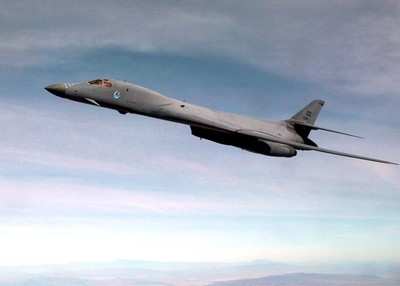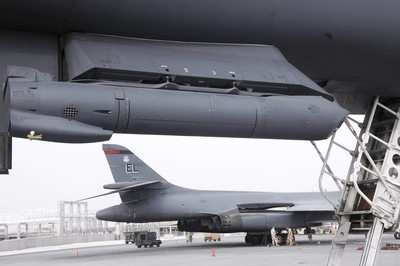New Targeting Pod Used To Drop Guided Munitions
The names of B-1B aircrew members interviewed for this
article are being withheld for operational security reasons --
Ed.
A Sniper Advanced Targeting Pod-equipped B-1B Lancer had its
first weapon employment in combat over Southwest Asia August 4,
successfully targeting enemy forces on the ground and dropping one
guided bomb unit-38 in support of Operation Enduring Freedom.
The Sniper ATP, a long-range precision targeting system,
provides enhanced target identification for aircrew, allowing them
to detect and analyze targets on the ground via real-time imagery.
The pod's advanced image processing algorithm, combined with its
stabilization techniques, out performs the best systems in service
today, according to Lockheed Martin, the manufacturer of the
pod.
B-1Bs were recently modified in order to carry the pod, which
has been integrated on various fighter aircraft, including the
F-15E, F-16 Block 30/40/50 and the A-10, since 2001.
In July 2006, US Air Forces Central filed an urgent need request
for a B-1B with advanced targeting pod capability, according to
Maj. Marc London, Headquarters US Air Force Combat Forces
Requirements, chief of bomber requirements. Following a request by
the Air Force's Combat Forces Requirements Division, Congress
allocated $24.7 million towards the project, paving the way for the
15-month acquisition, aircraft modification and testing phase.
Regulations implemented by the Strategic Arms Reduction Treaty
between the United States and the USSR played a role in why the
B-1B community is just now implementing the Sniper ATP.
"As a part of the START, B-1Bs were classified as no longer
nuclear capable and we were not authorized to use the exterior of
the aircraft to mount pods," said Lt. Col. Kevin Kennedy, 34th
Expeditionary Bomb Squadron commander. "We had to get approval to
mount the pods on the exterior of the aircraft."
The B-1B was originally designed for low-altitude, high-speed
flight against deliberate targets, Kennedy said.
"In today's fight, we are most often employed in a
close-air-support role from medium altitude," he said. "In that
capacity, a Sniper-equipped B-1B is an exponential increase in
combat capability."
Before the Sniper ATP, B-1B aircrews used only high-resolution
radar to "see" their targets.

"The big difference with radar is only large objects, like
buildings, are visible," said an aircraft commander from the 34th
EBS. "We could see buildings and vehicles but not people. Also,
radar is a picture in time whereas the pod provides us with
real-time, streaming video, which enhances our capability."
The Sniper ATP also eases communication with ground personnel,
allowing aircrew to put bombs on target quickly and precisely.
"Now the guys on the ground can see the video provided by the
pod at the same time as us and that's something we've never been
able to do before," another aircrew member said. "The pod also
gives us immediate bomb damage assessment whereas before, any
assessment had to come from someone on the ground."
The 34th EBS, deployed from Ellsworth Air Force Base, S.D., only
recently arrived at the 379th Air Expeditionary Wing. Prior to
their deployment, pilots, weapons systems officers and maintenance
personnel received required training on the Sniper ATP, which was
installed on the B-1B in April.
"The training requirement was significant because it took place
during our regular spin-up time prior to the deployment," Colonel
Kennedy said. "For aircrew, the training involved approximately 10
to 12 hours of academics, three flights for WSOs and two flights
for pilots. When you're talking 50 crewmembers flying the same
three aircraft, this is a challenge."
The 440-pound pod also posed a challenge to maintenance
personnel. Attached to the outside of the B-1B via an 884-pound
pylon, the pod requires specialized training for those responsible
for keeping the bomber in the air.
B-1B aircraft require a hard-point modification in order to
carry the pylon, the Sniper ATP, and extensive electrical and
aviation modifications were made in order to allow the Sniper to
operate with existing avionics, said Capt. Chris Glidden, 34th
Aircraft Maintenance Unit officer in charge.
"Training plays a critical role in fielding a new subsystem like
the Sniper pod," Captain Glidden said. "Avionics and weapons
systems technicians attend a school in Florida to learn how to
maintain, repair and up and download the pod and its supporting
pylon."
The Sniper ATP's design allows for true two-level maintenance
which eliminates costs and man hours related to intermediate-level
support. Prior to their deployment, maintenance personnel with the
34th AMU ensured more than 40 pieces of support equipment were in
theater in order to support the pod's arrival, Captain Glidden
said.
"Support equipment includes consolidated tool kits, specialized
adapters for bomb loaders and support dollies," he said.
"Additionally, several supply kit items required modification in
order to support this new critical capability."
Much of the essential maintenance equipment required software
upgrades and every maintenance and logistical organization from the
flightline to the back shops played a critical part in the Sniper
pod's arrival, Captain Glidden said.
"The Sniper pod itself may have made it into theater after a
two-day flight from home station but hundreds of maintenance and
logistics personnel spent many months behind the scenes to make it
happen," he said.
It takes approximately 45 days for a B-1B to be modified to
carry the Sniper ATP. Once the pylon is attached to the aircraft,
the pod is loaded with a MAU-12 bomb rack, according to Michael
Schnell, B-1B Avionics, Air Force Engineering and Technical
Services.
"The aircraft went to Davis-Monthan [Air Force Base, Ariz.,] for
modification and then to Ellsworth [AFB] where the aircrew and
maintenance personnel got to train with them," Mr. Schnell said.
"It's all very new to us but with the few flights we've had, it's
performed very well."
The Sniper ATP has a 97 percent mission capable rate and,
according to Mr. Schnell, the majority of required maintenance can
be performed with the pod still on the aircraft.
All B-1Bs assigned to the 379th AEW will soon be equipped with
the Sniper ATP and commanders here are already impressed with the
increased capability it has provided in the area of operations.
"Sniper ATP brings an amazing new capability to the already
amazing B-1B," said Col. Marilyn Kott, 379th Expeditionary
Operations Group commander. "It increases the speed and accuracy
with which the aircrew and the [joint tactical air controllers] can
execute the find-fix-track-target portion of the kill chain.

"Our enemies now have even less opportunity to avoid us, less
opportunity to get away and less opportunity to continue their
efforts against the populations of Iraq and Afghanistan," she said.
"We're honored to help bring Sniper to another aircraft in the AOR
and to help realize the culmination of years of work by many
people. We're glad to have the opportunity to employ it now in this
very critical fight that our coalition is waging."
(Aero-News salutes Capt. Kristen Pate, 379th Air
Expeditionary Wing Public Affairs)

 ANN's Daily Aero-Linx (04.15.24)
ANN's Daily Aero-Linx (04.15.24) Classic Aero-TV: 'No Other Options' -- The Israeli Air Force's Danny Shapira
Classic Aero-TV: 'No Other Options' -- The Israeli Air Force's Danny Shapira Aero-News: Quote of the Day (04.15.24)
Aero-News: Quote of the Day (04.15.24) Airborne 04.16.24: RV Update, Affordable Flying Expo, Diamond Lil
Airborne 04.16.24: RV Update, Affordable Flying Expo, Diamond Lil ANN's Daily Aero-Term (04.16.24): Chart Supplement US
ANN's Daily Aero-Term (04.16.24): Chart Supplement US





